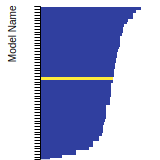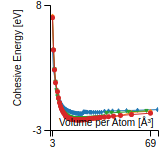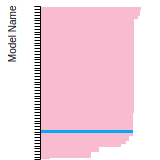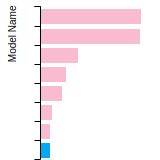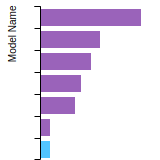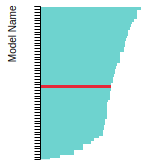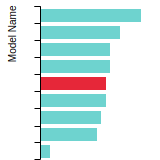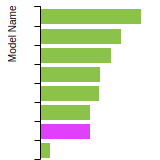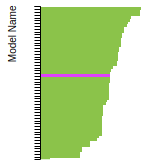Test
Test Results
Link to Test Results page
Benchmark time
Usertime multiplied by the Whetstone Benchmark. This number can be used (approximately) to compare the performance of different models independently of the architecture on which the test was run.
Conjugate gradient relaxation of random finite cluster of Si atoms v003
2087
Conjugate gradient relaxation of random finite cluster of Si atoms v003
3511
Conjugate gradient relaxation of random finite cluster of Si atoms v003
1789
Conjugate gradient relaxation of random finite cluster of Si atoms v003
3591
Conjugate gradient relaxation of random finite cluster of Si atoms v003
3700
Conjugate gradient relaxation of random finite cluster of Si atoms v003
3531
Conjugate gradient relaxation of random finite cluster of Si atoms v003
3600
Conjugate gradient relaxation of random finite cluster of Si atoms v003
3600
Conjugate gradient relaxation of random finite cluster of Si atoms v003
3710
Conjugate gradient relaxation of random finite cluster of Si atoms v003
1938
Conjugate gradient relaxation of random finite cluster of Si atoms v003
1826
Conjugate gradient relaxation of random finite cluster of Si atoms v003
3670
Conjugate gradient relaxation of random finite cluster of Si atoms v003
3770
Conjugate gradient relaxation of random finite cluster of Si atoms v003
3710
Conjugate gradient relaxation of random finite cluster of Si atoms v003
3620
Conjugate gradient relaxation of random finite cluster of Si atoms v003
1752
Conjugate gradient relaxation of random finite cluster of Si atoms v003
1789
Conjugate gradient relaxation of random finite cluster of Si atoms v003
3839
Conjugate gradient relaxation of random finite cluster of Si atoms v003
3280
Conjugate gradient relaxation of random finite cluster of Si atoms v003
1789
Conjugate gradient relaxation of random finite cluster of Si atoms v003
2497
Conjugate gradient relaxation of random finite cluster of Si atoms v003
3481
Conjugate gradient relaxation of random finite cluster of Si atoms v003
3700
Conjugate gradient relaxation of random finite cluster of Si atoms v003
1901
Conjugate gradient relaxation of random finite cluster of Si atoms v003
1752
Conjugate gradient relaxation of random finite cluster of Si atoms v003
1752
Conjugate gradient relaxation of random finite cluster of Si atoms v003
1826
Conjugate gradient relaxation of random finite cluster of Si atoms v003
3750
Conjugate gradient relaxation of random finite cluster of Si atoms v003
3640
Conjugate gradient relaxation of random finite cluster of Si atoms v003
1938
Conjugate gradient relaxation of random finite cluster of Si atoms v003
3750
Conjugate gradient relaxation of random finite cluster of Si atoms v003
2087
Conjugate gradient relaxation of random finite cluster of Si atoms v003
3551
Conjugate gradient relaxation of random finite cluster of Si atoms v003
2274
Conjugate gradient relaxation of random finite cluster of Si atoms v003
3581
Conjugate gradient relaxation of random finite cluster of Si atoms v003
1752
Conjugate gradient relaxation of random finite cluster of Si atoms v003
3205
Conjugate gradient relaxation of random finite cluster of Si atoms v003
3168
Conjugate gradient relaxation of random finite cluster of Si atoms v003
1603
Conjugate gradient relaxation of random finite cluster of Si atoms v003
1752
Conjugate gradient relaxation of random finite cluster of Si atoms v003
3571
Conjugate gradient relaxation of random finite cluster of Si atoms v003
1901
Conjugate gradient relaxation of random finite cluster of Si atoms v003
1864
Conjugate gradient relaxation of random finite cluster of Si atoms v003
3680
Conjugate gradient relaxation of random finite cluster of Si atoms v003
2274
Conjugate gradient relaxation of random finite cluster of Si atoms v003
3909
Conjugate gradient relaxation of random finite cluster of Si atoms v003
3630
Conjugate gradient relaxation of random finite cluster of Si atoms v003
2050
Conjugate gradient relaxation of random finite cluster of Si atoms v003
1715
Conjugate gradient relaxation of random finite cluster of Si atoms v003
1864
Conjugate gradient relaxation of random finite cluster of Si atoms v003
3700
Conjugate gradient relaxation of random finite cluster of Si atoms v003
1677
Conjugate gradient relaxation of random finite cluster of Si atoms v003
1789
Conjugate gradient relaxation of random finite cluster of Si atoms v003
1640
Conjugate gradient relaxation of random finite cluster of Si atoms v003
2758
Conjugate gradient relaxation of random finite cluster of Si atoms v003
3680
Conjugate gradient relaxation of random finite cluster of Si atoms v003
1677
Conjugate gradient relaxation of random finite cluster of Si atoms v003
3640
Conjugate gradient relaxation of random finite cluster of Si atoms v003
3581
Conjugate gradient relaxation of random finite cluster of Si atoms v003
3620
Conjugate gradient relaxation of random finite cluster of Si atoms v003
3730
Conjugate gradient relaxation of random finite cluster of Si atoms v003
3899
Conjugate gradient relaxation of random finite cluster of Si atoms v003
3929
Conjugate gradient relaxation of random finite cluster of Si atoms v003
3750
Conjugate gradient relaxation of random finite cluster of Si atoms v003
3779
Conjugate gradient relaxation of random finite cluster of Si atoms v003
1901
Conjugate gradient relaxation of random finite cluster of Si atoms v003
3760
Conjugate gradient relaxation of random finite cluster of Si atoms v003
2497
Conjugate gradient relaxation of random finite cluster of Si atoms v003
3650
Conjugate gradient relaxation of random finite cluster of Si atoms v003
1677
Conjugate gradient relaxation of random finite cluster of Si atoms v003
1603
Conjugate gradient relaxation of random finite cluster of Si atoms v003
3710
Conjugate gradient relaxation of random finite cluster of Si atoms v003
1864
Conjugate gradient relaxation of random finite cluster of Si atoms v003
3019
Conjugate gradient relaxation of random finite cluster of Si atoms v003
3919
Conjugate gradient relaxation of random finite cluster of Si atoms v003
3779
Conjugate gradient relaxation of random finite cluster of Si atoms v003
3660
Conjugate gradient relaxation of random finite cluster of Si atoms v003
1640
Conjugate gradient relaxation of random finite cluster of Si atoms v003
4028
Conjugate gradient relaxation of random finite cluster of Si atoms v003
2348
Conjugate gradient relaxation of random finite cluster of Si atoms v003
1677
Conjugate gradient relaxation of random finite cluster of Si atoms v003
3720
Conjugate gradient relaxation of random finite cluster of Si atoms v003
3809
Conjugate gradient relaxation of random finite cluster of Si atoms v003
3243
Conjugate gradient relaxation of random finite cluster of Si atoms v003
1789
Conjugate gradient relaxation of random finite cluster of Si atoms v003
1789
Conjugate gradient relaxation of random finite cluster of Si atoms v003
3829
Conjugate gradient relaxation of random finite cluster of Si atoms v003
3750
Conjugate gradient relaxation of random finite cluster of Si atoms v003
1752
Conjugate gradient relaxation of random finite cluster of Si atoms v003
1901
Conjugate gradient relaxation of random finite cluster of Si atoms v003
1938
Conjugate gradient relaxation of random finite cluster of Si atoms v003
2236
Conjugate gradient relaxation of random finite cluster of Si atoms v003
1715
Conjugate gradient relaxation of random finite cluster of Si atoms v003
1752
Conjugate gradient relaxation of random finite cluster of Si atoms v003
2348
Conjugate gradient relaxation of random finite cluster of Si atoms v003
3829
Conjugate gradient relaxation of random finite cluster of Si atoms v003
1603
Conjugate gradient relaxation of random finite cluster of Si atoms v003
3760
Conjugate gradient relaxation of random finite cluster of Si atoms v003
1864
Conjugate gradient relaxation of random finite cluster of Si atoms v003
3978
Conjugate gradient relaxation of random finite cluster of Si atoms v003
2013
Conjugate gradient relaxation of random finite cluster of Si atoms v003
3600
Conjugate gradient relaxation of random finite cluster of Si atoms v003
2311
Conjugate gradient relaxation of random finite cluster of Si atoms v003
1715
Conjugate gradient relaxation of random finite cluster of Si atoms v003
1677
Conjugate gradient relaxation of random finite cluster of Si atoms v003
3859
Conjugate gradient relaxation of random finite cluster of Si atoms v003
1901
Conjugate gradient relaxation of random finite cluster of Si atoms v003
1901
Conjugate gradient relaxation of random finite cluster of Si atoms v003
3809
Conjugate gradient relaxation of random finite cluster of Si atoms v003
3799
Conjugate gradient relaxation of random finite cluster of Si atoms v003
1715
Conjugate gradient relaxation of random finite cluster of Si atoms v003
2236
Conjugate gradient relaxation of random finite cluster of Si atoms v003
1789
Conjugate gradient relaxation of random finite cluster of Si atoms v003
1826
Conjugate gradient relaxation of random finite cluster of Si atoms v003
1603
Conjugate gradient relaxation of random finite cluster of Si atoms v003
3354
Conjugate gradient relaxation of random finite cluster of Si atoms v003
2087
Conjugate gradient relaxation of random finite cluster of Si atoms v003
3720
Conjugate gradient relaxation of random finite cluster of Si atoms v003
3660
Conjugate gradient relaxation of random finite cluster of Si atoms v003
1677
Conjugate gradient relaxation of random finite cluster of Si atoms v003
1677
Conjugate gradient relaxation of random finite cluster of Si atoms v003
2050
Conjugate gradient relaxation of random finite cluster of Si atoms v003
3600
Conjugate gradient relaxation of random finite cluster of Si atoms v003
2423
Conjugate gradient relaxation of random finite cluster of Si atoms v003
1603
Conjugate gradient relaxation of random finite cluster of Si atoms v003
1938
Conjugate gradient relaxation of random finite cluster of Si atoms v003
3521
Conjugate gradient relaxation of random finite cluster of Si atoms v003
3899
Conjugate gradient relaxation of random finite cluster of Si atoms v003
3819
Conjugate gradient relaxation of random finite cluster of Si atoms v003
3899
Conjugate gradient relaxation of random finite cluster of Si atoms v003
3819
Conjugate gradient relaxation of random finite cluster of Si atoms v003
3730
Conjugate gradient relaxation of random finite cluster of Si atoms v003
3630
Conjugate gradient relaxation of random finite cluster of Si atoms v003
1752
Conjugate gradient relaxation of random finite cluster of Si atoms v003
3610
Conjugate gradient relaxation of random finite cluster of Si atoms v003
3504
Conjugate gradient relaxation of random finite cluster of Si atoms v003
1752
Conjugate gradient relaxation of random finite cluster of Si atoms v003
3879
Conjugate gradient relaxation of random finite cluster of Si atoms v003
1789
Conjugate gradient relaxation of random finite cluster of Si atoms v003
3909
Conjugate gradient relaxation of random finite cluster of Si atoms v003
1901
Conjugate gradient relaxation of random finite cluster of Si atoms v003
2050
Conjugate gradient relaxation of random finite cluster of Si atoms v003
3859
Conjugate gradient relaxation of random finite cluster of Si atoms v003
1901
Conjugate gradient relaxation of random finite cluster of Si atoms v003
3710
Conjugate gradient relaxation of random finite cluster of Si atoms v003
1715
Conjugate gradient relaxation of random finite cluster of Si atoms v003
1864
Conjugate gradient relaxation of random finite cluster of Si atoms v003
1864
Conjugate gradient relaxation of random finite cluster of Si atoms v003
3670
Conjugate gradient relaxation of random finite cluster of Si atoms v003
2199
Conjugate gradient relaxation of random finite cluster of Si atoms v003
3750
Conjugate gradient relaxation of random finite cluster of Si atoms v003
2423
Conjugate gradient relaxation of random finite cluster of Si atoms v003
3829
Conjugate gradient relaxation of random finite cluster of Si atoms v003
3730
Conjugate gradient relaxation of random finite cluster of Si atoms v003
4028
Conjugate gradient relaxation of random finite cluster of Si atoms v003
3909
Conjugate gradient relaxation of random finite cluster of Si atoms v003
3710
Conjugate gradient relaxation of random finite cluster of Si atoms v003
3968
Conjugate gradient relaxation of random finite cluster of Si atoms v003
1975
Conjugate gradient relaxation of random finite cluster of Si atoms v003
3968
Conjugate gradient relaxation of random finite cluster of Si atoms v003
3760
Conjugate gradient relaxation of random finite cluster of Si atoms v003
2050
Conjugate gradient relaxation of random finite cluster of Si atoms v003
2013
Conjugate gradient relaxation of random finite cluster of Si atoms v003
3630
Conjugate gradient relaxation of random finite cluster of Si atoms v003
3839
Conjugate gradient relaxation of random finite cluster of Si atoms v003
3959
Conjugate gradient relaxation of random finite cluster of Si atoms v003
3929
Conjugate gradient relaxation of random finite cluster of Si atoms v003
3799
Conjugate gradient relaxation of random finite cluster of Si atoms v003
3799
Conjugate gradient relaxation of random finite cluster of Si atoms v003
3879
Conjugate gradient relaxation of random finite cluster of Si atoms v003
3581
Conjugate gradient relaxation of random finite cluster of Si atoms v003
3859
Conjugate gradient relaxation of random finite cluster of Si atoms v003
3700
Conjugate gradient relaxation of random finite cluster of Si atoms v003
3819
Conjugate gradient relaxation of random finite cluster of Si atoms v003
3809
Conjugate gradient relaxation of random finite cluster of Si atoms v003
1677
Conjugate gradient relaxation of random finite cluster of Si atoms v003
4048
Conjugate gradient relaxation of random finite cluster of Si atoms v003
1528
Conjugate gradient relaxation of random finite cluster of Si atoms v003
3959
Conjugate gradient relaxation of random finite cluster of Si atoms v003
1640
Conjugate gradient relaxation of random finite cluster of Si atoms v003
2050
Conjugate gradient relaxation of random finite cluster of Si atoms v003
1975
Conjugate gradient relaxation of random finite cluster of Si atoms v003
3131
Conjugate gradient relaxation of random finite cluster of Si atoms v003
3760
Conjugate gradient relaxation of random finite cluster of Si atoms v003
1826
Conjugate gradient relaxation of random finite cluster of Si atoms v003
2013
Conjugate gradient relaxation of random finite cluster of Si atoms v003
2125
Conjugate gradient relaxation of random finite cluster of Si atoms v003
3720
Conjugate gradient relaxation of random finite cluster of Si atoms v003
2087
Conjugate gradient relaxation of random finite cluster of Si atoms v003
3819
Conjugate gradient relaxation of random finite cluster of Si atoms v003
3799
Conjugate gradient relaxation of random finite cluster of Si atoms v003
3600
Conjugate gradient relaxation of random finite cluster of Si atoms v003
3750
Conjugate gradient relaxation of random finite cluster of Si atoms v003
3561
Conjugate gradient relaxation of random finite cluster of Si atoms v003
1677
Conjugate gradient relaxation of random finite cluster of Si atoms v003
1528
Conjugate gradient relaxation of random finite cluster of Si atoms v003
1715
Conjugate gradient relaxation of random finite cluster of Si atoms v003
3869
Conjugate gradient relaxation of random finite cluster of Si atoms v003
3690
Conjugate gradient relaxation of random finite cluster of Si atoms v003
3859
Conjugate gradient relaxation of random finite cluster of Si atoms v003
3869
Conjugate gradient relaxation of random finite cluster of Si atoms v003
1640
Conjugate gradient relaxation of random finite cluster of Si atoms v003
1715
Conjugate gradient relaxation of random finite cluster of Si atoms v003
3779
Conjugate gradient relaxation of random finite cluster of Si atoms v003
1938
Conjugate gradient relaxation of random finite cluster of Si atoms v003
1826
Conjugate gradient relaxation of random finite cluster of Si atoms v003
2013
Conjugate gradient relaxation of random finite cluster of Si atoms v003
3809
Conjugate gradient relaxation of random finite cluster of Si atoms v003
3710
Conjugate gradient relaxation of random finite cluster of Si atoms v003
3750
Conjugate gradient relaxation of random finite cluster of Si atoms v003
1938
Conjugate gradient relaxation of random finite cluster of Si atoms v003
1603
Conjugate gradient relaxation of random finite cluster of Si atoms v003
3541
Conjugate gradient relaxation of random finite cluster of Si atoms v003
3730
Conjugate gradient relaxation of random finite cluster of Si atoms v003
3909
Conjugate gradient relaxation of random finite cluster of Si atoms v003
3131
Conjugate gradient relaxation of random finite cluster of Si atoms v003
3779
Conjugate gradient relaxation of random finite cluster of Si atoms v003
3491
Conjugate gradient relaxation of random finite cluster of Si atoms v003
3551
Conjugate gradient relaxation of random finite cluster of Si atoms v003
3720
Conjugate gradient relaxation of random finite cluster of Si atoms v003
1640
Conjugate gradient relaxation of random finite cluster of Si atoms v003
1603
Conjugate gradient relaxation of random finite cluster of Si atoms v003
3581
Conjugate gradient relaxation of random finite cluster of Si atoms v003
1565
Conjugate gradient relaxation of random finite cluster of Si atoms v003
3501
Conjugate gradient relaxation of random finite cluster of Si atoms v003
3700
Conjugate gradient relaxation of random finite cluster of Si atoms v003
1975
Conjugate gradient relaxation of random finite cluster of Si atoms v003
1789
Conjugate gradient relaxation of random finite cluster of Si atoms v003
1864
Conjugate gradient relaxation of random finite cluster of Si atoms v003
3829
Conjugate gradient relaxation of random finite cluster of Si atoms v003
2274
Conjugate gradient relaxation of random finite cluster of Si atoms v003
3680
Conjugate gradient relaxation of random finite cluster of Si atoms v003
3720
Conjugate gradient relaxation of random finite cluster of Si atoms v003
3700
Conjugate gradient relaxation of random finite cluster of Si atoms v003
3690
Conjugate gradient relaxation of random finite cluster of Si atoms v003
3700
Conjugate gradient relaxation of random finite cluster of Si atoms v003
3859
Conjugate gradient relaxation of random finite cluster of Si atoms v003
3829
Conjugate gradient relaxation of random finite cluster of Si atoms v003
1677
Conjugate gradient relaxation of random finite cluster of Si atoms v003
1752
Conjugate gradient relaxation of random finite cluster of Si atoms v003
3959
Conjugate gradient relaxation of random finite cluster of Si atoms v003
1677
Conjugate gradient relaxation of random finite cluster of Si atoms v003
3909
Conjugate gradient relaxation of random finite cluster of Si atoms v003
1715
Conjugate gradient relaxation of random finite cluster of Si atoms v003
1677
Conjugate gradient relaxation of random finite cluster of Si atoms v003
3789
Conjugate gradient relaxation of random finite cluster of Si atoms v003
3929
Conjugate gradient relaxation of random finite cluster of Si atoms v003
3670
Conjugate gradient relaxation of random finite cluster of Si atoms v003
1565
Conjugate gradient relaxation of random finite cluster of Si atoms v003
3949
Conjugate gradient relaxation of random finite cluster of Si atoms v003
3317
Conjugate gradient relaxation of random finite cluster of Si atoms v003
1677
Conjugate gradient relaxation of random finite cluster of Si atoms v003
3770
Conjugate gradient relaxation of random finite cluster of Si atoms v003
1752
Conjugate gradient relaxation of random finite cluster of Si atoms v003
1603
Conjugate gradient relaxation of random finite cluster of Si atoms v003
3660
Conjugate gradient relaxation of random finite cluster of Si atoms v003
2162
Conjugate gradient relaxation of random finite cluster of Si atoms v003
1715
Conjugate gradient relaxation of random finite cluster of Si atoms v003
3720
Conjugate gradient relaxation of random finite cluster of Si atoms v003
1826
Conjugate gradient relaxation of random finite cluster of Si atoms v003
3504
Conjugate gradient relaxation of random finite cluster of Si atoms v003
3243
Conjugate gradient relaxation of random finite cluster of Si atoms v003
2050
Conjugate gradient relaxation of random finite cluster of Si atoms v003
3680
Conjugate gradient relaxation of random finite cluster of Si atoms v003
3094
Conjugate gradient relaxation of random finite cluster of Si atoms v003
1640
Conjugate gradient relaxation of random finite cluster of Si atoms v003
3779
Conjugate gradient relaxation of random finite cluster of Si atoms v003
3561
Conjugate gradient relaxation of random finite cluster of Si atoms v003
3551
Conjugate gradient relaxation of random finite cluster of Si atoms v003
3571
Conjugate gradient relaxation of random finite cluster of Si atoms v003
1826
Conjugate gradient relaxation of random finite cluster of Si atoms v003
3949
Conjugate gradient relaxation of random finite cluster of Si atoms v003
1864
Conjugate gradient relaxation of random finite cluster of Si atoms v003
3213
Conjugate gradient relaxation of random finite cluster of Si atoms v003
3859
Conjugate gradient relaxation of random finite cluster of Si atoms v003
3541
Conjugate gradient relaxation of random finite cluster of Si atoms v003
3730
Conjugate gradient relaxation of random finite cluster of Si atoms v003
2050
Conjugate gradient relaxation of random finite cluster of Si atoms v003
3849
Conjugate gradient relaxation of random finite cluster of Si atoms v003
3750
Conjugate gradient relaxation of random finite cluster of Si atoms v003
1938
Conjugate gradient relaxation of random finite cluster of Si atoms v003
3193
Conjugate gradient relaxation of random finite cluster of Si atoms v003
3779
Conjugate gradient relaxation of random finite cluster of Si atoms v003
3650
Conjugate gradient relaxation of random finite cluster of Si atoms v003
1789
Conjugate gradient relaxation of random finite cluster of Si atoms v003
3620
Conjugate gradient relaxation of random finite cluster of Si atoms v003
1677
Conjugate gradient relaxation of random finite cluster of Si atoms v003
1826
Conjugate gradient relaxation of random finite cluster of Si atoms v003
3581
Conjugate gradient relaxation of random finite cluster of Si atoms v003
1640
Conjugate gradient relaxation of random finite cluster of Si atoms v003
2721
Conjugate gradient relaxation of random finite cluster of Si atoms v003
1752
Conjugate gradient relaxation of random finite cluster of Si atoms v003
1975
Conjugate gradient relaxation of random finite cluster of Si atoms v003
1789
Conjugate gradient relaxation of random finite cluster of Si atoms v003
3660
Conjugate gradient relaxation of random finite cluster of Si atoms v003
3750
Conjugate gradient relaxation of random finite cluster of Si atoms v003
2944
Conjugate gradient relaxation of random finite cluster of Si atoms v003
3660
Conjugate gradient relaxation of random finite cluster of Si atoms v003
2162
Conjugate gradient relaxation of random finite cluster of Si atoms v003
3730
Conjugate gradient relaxation of random finite cluster of Si atoms v003
3615
Conjugate gradient relaxation of random finite cluster of Si atoms v003
3429
Conjugate gradient relaxation of random finite cluster of Si atoms v003
3770
Conjugate gradient relaxation of random finite cluster of Si atoms v003
1789
Conjugate gradient relaxation of random finite cluster of Si atoms v003
2162
Conjugate gradient relaxation of random finite cluster of Si atoms v003
2125
Conjugate gradient relaxation of random finite cluster of Si atoms v003
3849
Conjugate gradient relaxation of random finite cluster of Si atoms v003
1640
Conjugate gradient relaxation of random finite cluster of Si atoms v003
3968
Conjugate gradient relaxation of random finite cluster of Si atoms v003
3909
Conjugate gradient relaxation of random finite cluster of Si atoms v003
3740
Conjugate gradient relaxation of random finite cluster of Si atoms v003
1752
Conjugate gradient relaxation of random finite cluster of Si atoms v003
3869
Conjugate gradient relaxation of random finite cluster of Si atoms v003
1715
Conjugate gradient relaxation of random finite cluster of Si atoms v003
3700
Conjugate gradient relaxation of random finite cluster of Si atoms v003
3720
Conjugate gradient relaxation of random finite cluster of Si atoms v003
1975
Conjugate gradient relaxation of random finite cluster of Si atoms v003
3600
Conjugate gradient relaxation of random finite cluster of Si atoms v003
1938
Conjugate gradient relaxation of random finite cluster of Si atoms v003
1938
Conjugate gradient relaxation of random finite cluster of Si atoms v003
3680
Conjugate gradient relaxation of random finite cluster of Si atoms v003
3205
Conjugate gradient relaxation of random finite cluster of Si atoms v003
3504
Conjugate gradient relaxation of random finite cluster of Si atoms v003
1715
Conjugate gradient relaxation of random finite cluster of Si atoms v003
3511
Conjugate gradient relaxation of random finite cluster of Si atoms v003
3720
Conjugate gradient relaxation of random finite cluster of Si atoms v003
3640
Conjugate gradient relaxation of random finite cluster of Si atoms v003
3730
Conjugate gradient relaxation of random finite cluster of Si atoms v003
1752
Conjugate gradient relaxation of random finite cluster of Si atoms v003
1789
Conjugate gradient relaxation of random finite cluster of Si atoms v003
1938
Conjugate gradient relaxation of random finite cluster of Si atoms v003
1975
Conjugate gradient relaxation of random finite cluster of Si atoms v003
2311
Conjugate gradient relaxation of random finite cluster of Si atoms v003
1677
Conjugate gradient relaxation of random finite cluster of Si atoms v003
4237
Conjugate gradient relaxation of random finite cluster of Si atoms v003
3610
Conjugate gradient relaxation of random finite cluster of Si atoms v003
3571
Conjugate gradient relaxation of random finite cluster of Si atoms v003
3392
Conjugate gradient relaxation of random finite cluster of Si atoms v003
3541
Conjugate gradient relaxation of random finite cluster of Si atoms v003
3571
Conjugate gradient relaxation of random finite cluster of Si atoms v003
2125
Conjugate gradient relaxation of random finite cluster of Si atoms v003
2609
Conjugate gradient relaxation of random finite cluster of Si atoms v003
3610
Conjugate gradient relaxation of random finite cluster of Si atoms v003
3670
Conjugate gradient relaxation of random finite cluster of Si atoms v003
3879
Conjugate gradient relaxation of random finite cluster of Si atoms v003
1975
Conjugate gradient relaxation of random finite cluster of Si atoms v003
1901
Conjugate gradient relaxation of random finite cluster of Si atoms v003
1826
Conjugate gradient relaxation of random finite cluster of Si atoms v003
3829
Conjugate gradient relaxation of random finite cluster of Si atoms v003
3730
Conjugate gradient relaxation of random finite cluster of Si atoms v003
3949
Conjugate gradient relaxation of random finite cluster of Si atoms v003
1901
Conjugate gradient relaxation of random finite cluster of Si atoms v003
1901
Conjugate gradient relaxation of random finite cluster of Si atoms v003
1826
Conjugate gradient relaxation of random finite cluster of Si atoms v003
1565
Conjugate gradient relaxation of random finite cluster of Si atoms v003
3501
Conjugate gradient relaxation of random finite cluster of Si atoms v003
2795
Conjugate gradient relaxation of random finite cluster of Si atoms v003
4068
Conjugate gradient relaxation of random finite cluster of Si atoms v003
2125
Conjugate gradient relaxation of random finite cluster of Si atoms v003
1677
Conjugate gradient relaxation of random finite cluster of Si atoms v003
1715
Conjugate gradient relaxation of random finite cluster of Si atoms v003
3789
Conjugate gradient relaxation of random finite cluster of Si atoms v003
3760
Conjugate gradient relaxation of random finite cluster of Si atoms v003
3710
Conjugate gradient relaxation of random finite cluster of Si atoms v003
1677
Conjugate gradient relaxation of random finite cluster of Si atoms v003
2423
Conjugate gradient relaxation of random finite cluster of Si atoms v003
3501
Conjugate gradient relaxation of random finite cluster of Si atoms v003
1715
Conjugate gradient relaxation of random finite cluster of Si atoms v003
3610
Conjugate gradient relaxation of random finite cluster of Si atoms v003
1603
Conjugate gradient relaxation of random finite cluster of Si atoms v003
1715
Conjugate gradient relaxation of random finite cluster of Si atoms v003
3670
Conjugate gradient relaxation of random finite cluster of Si atoms v003
3799
Conjugate gradient relaxation of random finite cluster of Si atoms v003
3650
Conjugate gradient relaxation of random finite cluster of Si atoms v003
3809
Conjugate gradient relaxation of random finite cluster of Si atoms v003
1901
Conjugate gradient relaxation of random finite cluster of Si atoms v003
3720
Conjugate gradient relaxation of random finite cluster of Si atoms v003
2013
Conjugate gradient relaxation of random finite cluster of Si atoms v003
1752
Conjugate gradient relaxation of random finite cluster of Si atoms v003
1789
Conjugate gradient relaxation of random finite cluster of Si atoms v003
2274
Conjugate gradient relaxation of random finite cluster of Si atoms v003
3551
Conjugate gradient relaxation of random finite cluster of Si atoms v003
3770
Conjugate gradient relaxation of random finite cluster of Si atoms v003
3354
Conjugate gradient relaxation of random finite cluster of Si atoms v003
3839
Conjugate gradient relaxation of random finite cluster of Si atoms v003
3600
Conjugate gradient relaxation of random finite cluster of Si atoms v003
3581
Conjugate gradient relaxation of random finite cluster of Si atoms v003
3899
Conjugate gradient relaxation of random finite cluster of Si atoms v003
3799
Conjugate gradient relaxation of random finite cluster of Si atoms v003
1938
Conjugate gradient relaxation of random finite cluster of Si atoms v003
3640
Conjugate gradient relaxation of random finite cluster of Si atoms v003
1752
Conjugate gradient relaxation of random finite cluster of Si atoms v003
3650
Conjugate gradient relaxation of random finite cluster of Si atoms v003
3849
Conjugate gradient relaxation of random finite cluster of Si atoms v003
1752
Conjugate gradient relaxation of random finite cluster of Si atoms v003
3859
Conjugate gradient relaxation of random finite cluster of Si atoms v003
2646
Conjugate gradient relaxation of random finite cluster of Si atoms v003
3998
Conjugate gradient relaxation of random finite cluster of Si atoms v003
1864
Conjugate gradient relaxation of random finite cluster of Si atoms v003
3779
Conjugate gradient relaxation of random finite cluster of Si atoms v003
3829
Conjugate gradient relaxation of random finite cluster of Si atoms v003
3561
Conjugate gradient relaxation of random finite cluster of Si atoms v003
2236
Conjugate gradient relaxation of random finite cluster of Si atoms v003
2460
Conjugate gradient relaxation of random finite cluster of Si atoms v003
2236
Conjugate gradient relaxation of random finite cluster of Si atoms v003
3859
Conjugate gradient relaxation of random finite cluster of Si atoms v003
1789
Conjugate gradient relaxation of random finite cluster of Si atoms v003
3869
Conjugate gradient relaxation of random finite cluster of Si atoms v003
3600
Conjugate gradient relaxation of random finite cluster of Si atoms v003
3968
Conjugate gradient relaxation of random finite cluster of Si atoms v003
1715
Conjugate gradient relaxation of random finite cluster of Si atoms v003
3760
Conjugate gradient relaxation of random finite cluster of Si atoms v003
3869
Conjugate gradient relaxation of random finite cluster of Si atoms v003
1677
Conjugate gradient relaxation of random finite cluster of Si atoms v003
2609
Conjugate gradient relaxation of random finite cluster of Si atoms v003
3680
Conjugate gradient relaxation of random finite cluster of Si atoms v003
3720
Conjugate gradient relaxation of random finite cluster of Si atoms v003
4038
Conjugate gradient relaxation of random finite cluster of Si atoms v003
3740
Conjugate gradient relaxation of random finite cluster of Si atoms v003
1677
Conjugate gradient relaxation of random finite cluster of Si atoms v003
1864
Conjugate gradient relaxation of random finite cluster of Si atoms v003
2609
Conjugate gradient relaxation of random finite cluster of Si atoms v003
1975
Conjugate gradient relaxation of random finite cluster of Si atoms v003
1975
Conjugate gradient relaxation of random finite cluster of Si atoms v003
3929
Conjugate gradient relaxation of random finite cluster of Si atoms v003
1864
Conjugate gradient relaxation of random finite cluster of Si atoms v003
1938
Conjugate gradient relaxation of random finite cluster of Si atoms v003
2423
Conjugate gradient relaxation of random finite cluster of Si atoms v003
2609
Conjugate gradient relaxation of random finite cluster of Si atoms v003
3730
Conjugate gradient relaxation of random finite cluster of Si atoms v003
2348
Conjugate gradient relaxation of random finite cluster of Si atoms v003
3094
Conjugate gradient relaxation of random finite cluster of Si atoms v003
1715
Conjugate gradient relaxation of random finite cluster of Si atoms v003
2087
Conjugate gradient relaxation of random finite cluster of Si atoms v003
3650
Conjugate gradient relaxation of random finite cluster of Si atoms v003
3610
Conjugate gradient relaxation of random finite cluster of Si atoms v003
1975
Conjugate gradient relaxation of random finite cluster of Si atoms v003
3998
Conjugate gradient relaxation of random finite cluster of Si atoms v003
3929
Conjugate gradient relaxation of random finite cluster of Si atoms v003
1789
Conjugate gradient relaxation of random finite cluster of Si atoms v003
2274
Conjugate gradient relaxation of random finite cluster of Si atoms v003
3889
Conjugate gradient relaxation of random finite cluster of Si atoms v003
2199
Conjugate gradient relaxation of random finite cluster of Si atoms v003
3770
Conjugate gradient relaxation of random finite cluster of Si atoms v003
2646
Conjugate gradient relaxation of random finite cluster of Si atoms v003
3561
Conjugate gradient relaxation of random finite cluster of Si atoms v003
3789
Conjugate gradient relaxation of random finite cluster of Si atoms v003
1752
Conjugate gradient relaxation of random finite cluster of Si atoms v003
3740
Conjugate gradient relaxation of random finite cluster of Si atoms v003
1715
Conjugate gradient relaxation of random finite cluster of Si atoms v003
1752
Conjugate gradient relaxation of random finite cluster of Si atoms v003
2162
Conjugate gradient relaxation of random finite cluster of Si atoms v003
3968
Conjugate gradient relaxation of random finite cluster of Si atoms v003
4068
Conjugate gradient relaxation of random finite cluster of Si atoms v003
2460
Conjugate gradient relaxation of random finite cluster of Si atoms v003
3730
Conjugate gradient relaxation of random finite cluster of Si atoms v003
1901
Conjugate gradient relaxation of random finite cluster of Si atoms v003
1864
Conjugate gradient relaxation of random finite cluster of Si atoms v003
3849
Conjugate gradient relaxation of random finite cluster of Si atoms v003
1640
Conjugate gradient relaxation of random finite cluster of Si atoms v003
3949
Conjugate gradient relaxation of random finite cluster of Si atoms v003
1752
Conjugate gradient relaxation of random finite cluster of Si atoms v003
3710
Conjugate gradient relaxation of random finite cluster of Si atoms v003
3690
Conjugate gradient relaxation of random finite cluster of Si atoms v003
4078
Conjugate gradient relaxation of random finite cluster of Si atoms v003
3789
Conjugate gradient relaxation of random finite cluster of Si atoms v003
1938
Conjugate gradient relaxation of random finite cluster of Si atoms v003
3690
Conjugate gradient relaxation of random finite cluster of Si atoms v003
3859
Conjugate gradient relaxation of random finite cluster of Si atoms v003
2907
Conjugate gradient relaxation of random finite cluster of Si atoms v003
1677
Conjugate gradient relaxation of random finite cluster of Si atoms v003
1789
Conjugate gradient relaxation of random finite cluster of Si atoms v003
1752
Conjugate gradient relaxation of random finite cluster of Si atoms v003
2087
Conjugate gradient relaxation of random finite cluster of Si atoms v003
1975
Conjugate gradient relaxation of random finite cluster of Si atoms v003
2050
Conjugate gradient relaxation of random finite cluster of Si atoms v003
1789
Conjugate gradient relaxation of random finite cluster of Si atoms v003
2423
Conjugate gradient relaxation of random finite cluster of Si atoms v003
3680
Conjugate gradient relaxation of random finite cluster of Si atoms v003
3660
Conjugate gradient relaxation of random finite cluster of Si atoms v003
3471
Conjugate gradient relaxation of random finite cluster of Si atoms v003
2013
Conjugate gradient relaxation of random finite cluster of Si atoms v003
3770
Conjugate gradient relaxation of random finite cluster of Si atoms v003
3581
Conjugate gradient relaxation of random finite cluster of Si atoms v003
3710
Conjugate gradient relaxation of random finite cluster of Si atoms v003
1789
Conjugate gradient relaxation of random finite cluster of Si atoms v003
2534
Conjugate gradient relaxation of random finite cluster of Si atoms v003
3581
Conjugate gradient relaxation of random finite cluster of Si atoms v003
3630
Conjugate gradient relaxation of random finite cluster of Si atoms v003
3730
Conjugate gradient relaxation of random finite cluster of Si atoms v003
3354
Conjugate gradient relaxation of random finite cluster of Si atoms v003
3610
Conjugate gradient relaxation of random finite cluster of Si atoms v003
3620
Conjugate gradient relaxation of random finite cluster of Si atoms v003
3799
Conjugate gradient relaxation of random finite cluster of Si atoms v003
3730
Conjugate gradient relaxation of random finite cluster of Si atoms v003
1752
Conjugate gradient relaxation of random finite cluster of Si atoms v003
3710
Conjugate gradient relaxation of random finite cluster of Si atoms v003
2050
Conjugate gradient relaxation of random finite cluster of Si atoms v003
1603
Conjugate gradient relaxation of random finite cluster of Si atoms v003
1789
Conjugate gradient relaxation of random finite cluster of Si atoms v003
3710
Conjugate gradient relaxation of random finite cluster of Si atoms v003
3571
Conjugate gradient relaxation of random finite cluster of Si atoms v003
3640
Conjugate gradient relaxation of random finite cluster of Si atoms v003
1826
Conjugate gradient relaxation of random finite cluster of Si atoms v003
3750
Conjugate gradient relaxation of random finite cluster of Si atoms v003
3899
Conjugate gradient relaxation of random finite cluster of Si atoms v003
3899
Conjugate gradient relaxation of random finite cluster of Si atoms v003
1864
Conjugate gradient relaxation of random finite cluster of Si atoms v003
1975
Conjugate gradient relaxation of random finite cluster of Si atoms v003
3889
Conjugate gradient relaxation of random finite cluster of Si atoms v003
3650
Conjugate gradient relaxation of random finite cluster of Si atoms v003
1789
Conjugate gradient relaxation of random finite cluster of Si atoms v003
3620
Conjugate gradient relaxation of random finite cluster of Si atoms v003
1826
Conjugate gradient relaxation of random finite cluster of Si atoms v003
3610
Conjugate gradient relaxation of random finite cluster of Si atoms v003
1901
Conjugate gradient relaxation of random finite cluster of Si atoms v003
2236
Conjugate gradient relaxation of random finite cluster of Si atoms v003
3839
Conjugate gradient relaxation of random finite cluster of Si atoms v003
1789
Conjugate gradient relaxation of random finite cluster of Si atoms v003
1640
Conjugate gradient relaxation of random finite cluster of Si atoms v003
1938
Conjugate gradient relaxation of random finite cluster of Si atoms v003
1715
Conjugate gradient relaxation of random finite cluster of Si atoms v003
4048
Conjugate gradient relaxation of random finite cluster of Si atoms v003
1752
Conjugate gradient relaxation of random finite cluster of Si atoms v003
3280
Conjugate gradient relaxation of random finite cluster of Si atoms v003
1789
Conjugate gradient relaxation of random finite cluster of Si atoms v003
1938
Conjugate gradient relaxation of random finite cluster of Si atoms v003
1826
Conjugate gradient relaxation of random finite cluster of Si atoms v003
3909
Conjugate gradient relaxation of random finite cluster of Si atoms v003
1715
Conjugate gradient relaxation of random finite cluster of Si atoms v003
1715
Conjugate gradient relaxation of random finite cluster of Si atoms v003
3680
Conjugate gradient relaxation of random finite cluster of Si atoms v003
2162
Conjugate gradient relaxation of random finite cluster of Si atoms v003
3779
Conjugate gradient relaxation of random finite cluster of Si atoms v003
1752
Conjugate gradient relaxation of random finite cluster of Si atoms v003
1789
Conjugate gradient relaxation of random finite cluster of Si atoms v003
3730
Conjugate gradient relaxation of random finite cluster of Si atoms v003
3690
Conjugate gradient relaxation of random finite cluster of Si atoms v003
2087
Conjugate gradient relaxation of random finite cluster of Si atoms v003
1565
Conjugate gradient relaxation of random finite cluster of Si atoms v003
2311
Conjugate gradient relaxation of random finite cluster of Si atoms v003
1901
Conjugate gradient relaxation of random finite cluster of Si atoms v003
3740
Conjugate gradient relaxation of random finite cluster of Si atoms v003
2423
Conjugate gradient relaxation of random finite cluster of Si atoms v003
3770
Conjugate gradient relaxation of random finite cluster of Si atoms v003
3710
Conjugate gradient relaxation of random finite cluster of Si atoms v003
2013
Conjugate gradient relaxation of random finite cluster of Si atoms v003
2236
Conjugate gradient relaxation of random finite cluster of Si atoms v003
2050
Conjugate gradient relaxation of random finite cluster of Si atoms v003
3839
Conjugate gradient relaxation of random finite cluster of Si atoms v003
1826
Conjugate gradient relaxation of random finite cluster of Si atoms v003
3750
Conjugate gradient relaxation of random finite cluster of Si atoms v003
3799
Conjugate gradient relaxation of random finite cluster of Si atoms v003
3690
Conjugate gradient relaxation of random finite cluster of Si atoms v003
3929
Conjugate gradient relaxation of random finite cluster of Si atoms v003
3799
Conjugate gradient relaxation of random finite cluster of Si atoms v003
3700
Conjugate gradient relaxation of random finite cluster of Si atoms v003
3779
Conjugate gradient relaxation of random finite cluster of Si atoms v003
1864
Conjugate gradient relaxation of random finite cluster of Si atoms v003
3521
Conjugate gradient relaxation of random finite cluster of Si atoms v003
1715
Conjugate gradient relaxation of random finite cluster of Si atoms v003
3670
Conjugate gradient relaxation of random finite cluster of Si atoms v003
2348
Conjugate gradient relaxation of random finite cluster of Si atoms v003
1677
Conjugate gradient relaxation of random finite cluster of Si atoms v003
2013
Conjugate gradient relaxation of random finite cluster of Si atoms v003
1565
Conjugate gradient relaxation of random finite cluster of Si atoms v003
1789
Conjugate gradient relaxation of random finite cluster of Si atoms v003
1975
Conjugate gradient relaxation of random finite cluster of Si atoms v003
3727
Conjugate gradient relaxation of random finite cluster of Si atoms v003
3131
Conjugate gradient relaxation of random finite cluster of Si atoms v003
3730
Conjugate gradient relaxation of random finite cluster of Si atoms v003
2348
Conjugate gradient relaxation of random finite cluster of Si atoms v003
3730
Conjugate gradient relaxation of random finite cluster of Si atoms v003
2348
Conjugate gradient relaxation of random finite cluster of Si atoms v003
3779
Conjugate gradient relaxation of random finite cluster of Si atoms v003
1752
Conjugate gradient relaxation of random finite cluster of Si atoms v003
1677
Conjugate gradient relaxation of random finite cluster of Si atoms v003
2087
Conjugate gradient relaxation of random finite cluster of Si atoms v003
1901
Conjugate gradient relaxation of random finite cluster of Si atoms v003
3690
Conjugate gradient relaxation of random finite cluster of Si atoms v003
1677
Conjugate gradient relaxation of random finite cluster of Si atoms v003
3280
Conjugate gradient relaxation of random finite cluster of Si atoms v003
3280
Conjugate gradient relaxation of random finite cluster of Si atoms v003
2982
Conjugate gradient relaxation of random finite cluster of Si atoms v003
3511
Conjugate gradient relaxation of random finite cluster of Si atoms v003
1640
Conjugate gradient relaxation of random finite cluster of Si atoms v003
1603
Conjugate gradient relaxation of random finite cluster of Si atoms v003
2236
Conjugate gradient relaxation of random finite cluster of Si atoms v003
3809
Conjugate gradient relaxation of random finite cluster of Si atoms v003
2385
Conjugate gradient relaxation of random finite cluster of Si atoms v003
3620
Conjugate gradient relaxation of random finite cluster of Si atoms v003
1864
Conjugate gradient relaxation of random finite cluster of Si atoms v003
2125
Conjugate gradient relaxation of random finite cluster of Si atoms v003
3770
Conjugate gradient relaxation of random finite cluster of Si atoms v003
1752
Conjugate gradient relaxation of random finite cluster of Si atoms v003
2050
Conjugate gradient relaxation of random finite cluster of Si atoms v003
1826
Conjugate gradient relaxation of random finite cluster of Si atoms v003
3750
Conjugate gradient relaxation of random finite cluster of Si atoms v003
3779
Conjugate gradient relaxation of random finite cluster of Si atoms v003
3770
Conjugate gradient relaxation of random finite cluster of Si atoms v003
3243
Conjugate gradient relaxation of random finite cluster of Si atoms v003
3799
Conjugate gradient relaxation of random finite cluster of Si atoms v003
3640
Conjugate gradient relaxation of random finite cluster of Si atoms v003
3959
Conjugate gradient relaxation of random finite cluster of Si atoms v003
1826
Conjugate gradient relaxation of random finite cluster of Si atoms v003
1789
Conjugate gradient relaxation of random finite cluster of Si atoms v003
1677
Conjugate gradient relaxation of random finite cluster of Si atoms v003
2162
Conjugate gradient relaxation of random finite cluster of Si atoms v003
3789
Conjugate gradient relaxation of random finite cluster of Si atoms v003
1901
Conjugate gradient relaxation of random finite cluster of Si atoms v003
3849
Conjugate gradient relaxation of random finite cluster of Si atoms v003
3889
Conjugate gradient relaxation of random finite cluster of Si atoms v003
3839
Conjugate gradient relaxation of random finite cluster of Si atoms v003
3710
Conjugate gradient relaxation of random finite cluster of Si atoms v003
3354
Conjugate gradient relaxation of random finite cluster of Si atoms v003
3680
Conjugate gradient relaxation of random finite cluster of Si atoms v003
3504
Conjugate gradient relaxation of random finite cluster of Si atoms v003
3849
Conjugate gradient relaxation of random finite cluster of Si atoms v003
3610
Conjugate gradient relaxation of random finite cluster of Si atoms v003
3561
Conjugate gradient relaxation of random finite cluster of Si atoms v003
1752
Conjugate gradient relaxation of random finite cluster of Si atoms v003
3889
Conjugate gradient relaxation of random finite cluster of Si atoms v003
1565
Conjugate gradient relaxation of random finite cluster of Si atoms v003
2013
Conjugate gradient relaxation of random finite cluster of Si atoms v003
2423
Conjugate gradient relaxation of random finite cluster of Si atoms v003
2013
Conjugate gradient relaxation of random finite cluster of Si atoms v003
3660
Conjugate gradient relaxation of random finite cluster of Si atoms v003
3541
Conjugate gradient relaxation of random finite cluster of Si atoms v003
3690
Conjugate gradient relaxation of random finite cluster of Si atoms v003
3899
Conjugate gradient relaxation of random finite cluster of Si atoms v003
1752
Conjugate gradient relaxation of random finite cluster of Si atoms v003
1789
Conjugate gradient relaxation of random finite cluster of Si atoms v003
1975
Conjugate gradient relaxation of random finite cluster of Si atoms v003
3610
Conjugate gradient relaxation of random finite cluster of Si atoms v003
3541
Conjugate gradient relaxation of random finite cluster of Si atoms v003
2460
Conjugate gradient relaxation of random finite cluster of Si atoms v003
3919
Conjugate gradient relaxation of random finite cluster of Si atoms v003
3610
Conjugate gradient relaxation of random finite cluster of Si atoms v003
1715
Conjugate gradient relaxation of random finite cluster of Si atoms v003
2125
Conjugate gradient relaxation of random finite cluster of Si atoms v003
4058
Conjugate gradient relaxation of random finite cluster of Si atoms v003
2199
Conjugate gradient relaxation of random finite cluster of Si atoms v003
3504
Conjugate gradient relaxation of random finite cluster of Si atoms v003
3504
Conjugate gradient relaxation of random finite cluster of Si atoms v003
3819
Conjugate gradient relaxation of random finite cluster of Si atoms v003
1864
Conjugate gradient relaxation of random finite cluster of Si atoms v003
1975
Conjugate gradient relaxation of random finite cluster of Si atoms v003
2907
Conjugate gradient relaxation of random finite cluster of Si atoms v003
3750
Conjugate gradient relaxation of random finite cluster of Si atoms v003
1901
Conjugate gradient relaxation of random finite cluster of Si atoms v003
3819
Conjugate gradient relaxation of random finite cluster of Si atoms v003
3779
Conjugate gradient relaxation of random finite cluster of Si atoms v003
1752
Conjugate gradient relaxation of random finite cluster of Si atoms v003
4008
Conjugate gradient relaxation of random finite cluster of Si atoms v003
3750
Conjugate gradient relaxation of random finite cluster of Si atoms v003
1938
Conjugate gradient relaxation of random finite cluster of Si atoms v003
1789
Conjugate gradient relaxation of random finite cluster of Si atoms v003
1975
Conjugate gradient relaxation of random finite cluster of Si atoms v003
3680
Conjugate gradient relaxation of random finite cluster of Si atoms v003
1826
Conjugate gradient relaxation of random finite cluster of Si atoms v003
3829
Conjugate gradient relaxation of random finite cluster of Si atoms v003
3859
Conjugate gradient relaxation of random finite cluster of Si atoms v003
3205
Conjugate gradient relaxation of random finite cluster of Si atoms v003
3770
Conjugate gradient relaxation of random finite cluster of Si atoms v003
1677
Conjugate gradient relaxation of random finite cluster of Si atoms v003
2162
Conjugate gradient relaxation of random finite cluster of Si atoms v003
3939
Conjugate gradient relaxation of random finite cluster of Si atoms v003
2087
Conjugate gradient relaxation of random finite cluster of Si atoms v003
3491
Conjugate gradient relaxation of random finite cluster of Si atoms v003
3829
Conjugate gradient relaxation of random finite cluster of Si atoms v003
1752
Conjugate gradient relaxation of random finite cluster of Si atoms v003
3710
Conjugate gradient relaxation of random finite cluster of Si atoms v003
2534
Conjugate gradient relaxation of random finite cluster of Si atoms v003
3889
Conjugate gradient relaxation of random finite cluster of Si atoms v003
2385
Conjugate gradient relaxation of random finite cluster of Si atoms v003
1640
Conjugate gradient relaxation of random finite cluster of Si atoms v003
3640
Conjugate gradient relaxation of random finite cluster of Si atoms v003
1640
Conjugate gradient relaxation of random finite cluster of Si atoms v003
1603
Conjugate gradient relaxation of random finite cluster of Si atoms v003
2199
Conjugate gradient relaxation of random finite cluster of Si atoms v003
3919
Conjugate gradient relaxation of random finite cluster of Si atoms v003
1715
Conjugate gradient relaxation of random finite cluster of Si atoms v003
1864
Conjugate gradient relaxation of random finite cluster of Si atoms v003
3466
Conjugate gradient relaxation of random finite cluster of Si atoms v003
1715
Conjugate gradient relaxation of random finite cluster of Si atoms v003
3919
Conjugate gradient relaxation of random finite cluster of Si atoms v003
4038
Conjugate gradient relaxation of random finite cluster of Si atoms v003
4088
Conjugate gradient relaxation of random finite cluster of Si atoms v003
4108
Conjugate gradient relaxation of random finite cluster of Si atoms v003
2087
Conjugate gradient relaxation of random finite cluster of Si atoms v003
3879
Conjugate gradient relaxation of random finite cluster of Si atoms v003
2087
Conjugate gradient relaxation of random finite cluster of Si atoms v003
3690
Conjugate gradient relaxation of random finite cluster of Si atoms v003
3799
Conjugate gradient relaxation of random finite cluster of Si atoms v003
3819
Conjugate gradient relaxation of random finite cluster of Si atoms v003
3610
 MEAM_LAMMPS_CuiGaoCui_2012_LiSi__MO_557492625287_001
MEAM_LAMMPS_CuiGaoCui_2012_LiSi__MO_557492625287_001
